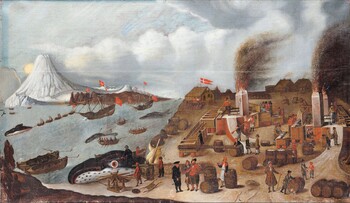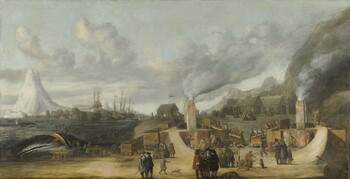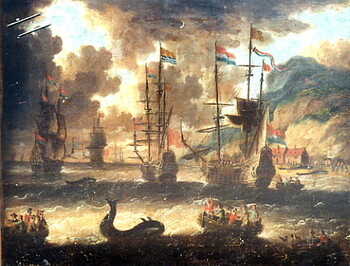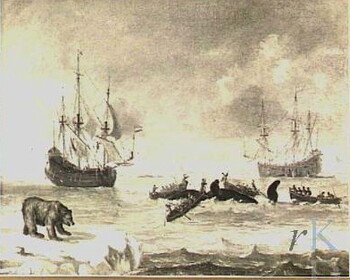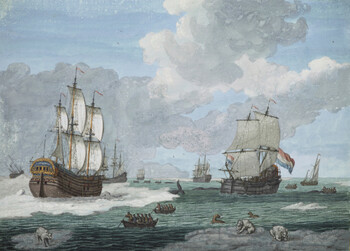8.700 €
Dutch whalers in the Arctic on Spitsbergen
Oil on panel : 58,2 X 76,0 cm
Unsigned
Frame (needs to be replaced) : 74,4 X 92,4 cm
In short
Before petroleum, the fat under the whale’s skin was used as fuel in oil lamps and as wax in candles. During Summer, whale hunt became a very lucrative business in the Arctic waters and off Greenland. Once the animal had been killed with a harpoon it floated on the waters and could therefore easily be brought ashore. Here all its oil was won within two or three days by boiling massive humps of it in large cauldrons.
About early whale hunting
The first to hunt whales on a large scale for commercial reasons were the Basques in the 16th century. They sold whale meat and blubber to the rest of Europe. Blubber, that is the fat under the whale’s skin was used as fuel in oil lamps and as wax in candles. It also served in the production of soap, leather and cosmetics. The Basques were successful whale killers because they attached a rope to the harpoon and fixed it to their whaleboat so that the whale could not escape. Whale hunters sitting in their small whaleboat with a rope attached to a harpoon that has pierced a whale were said “to be sitting on a Spanish barrow”. This of course referred to the (Spanish) Basques, whom they learned to hunt the whales from.
By the late 16th century, the Dutch, English and Danes started hunting whales. They used the skilled Basque harpooners and shippers. Once they learned all their skills, they chased all Basque ships away from the main Arctic whaling grounds off Spitsbergen (Svalbard), Jan Mayen Island and Greenland. The name Spitsbergen referred during the 17th and 18th century to the Svalbard islands North of Norway, well into the Pole Circle, today it is the name of the biggest island. Whaling rapidly became big business and it took industrial proportions: a lot of animals were killed and as there was a lot of money to be gained there was a lot of hostility and incidents between the Dutch, English, Danes and French. Later the Germans also joined in.
Whaling was a strict summer activity. The ships would leave in June. It would take them three weeks to arrive from the Dutch Republic in the Arctic hunting waters. In September or early October they would leave for Holland again.
John F. Richards in “The unending frontier: an environmental history of the early modern world” (2003, P. 597) gives us an idea of the number of Dutch whaling ships active in the Arctic from Spitsbergen: 20/30 in the 1620 s and 1630s, 70 in 1654, 148 in 1670. In 1684 they reached the highest number: 246 Dutch whalers had then cached 1.185 whales.
The favourite hunted whale was the bowhead (also called Arctic whale): it was large, slow and fat. Fat meant it had a lot of blubber and the animal floated on the sea after it was killed.
Originally, up till the 1640s –1670s the bowheads were being hunted in the sheltered coastal waters of Spitsbergen. After the animals had fled the waters round Spitsbergen, which were infested with whalers during summer, the hunters had to follow their prey into the open waters along the borders of the drift ice W from Spitsbergen towards E. Greenland. This was more dangerous, for the ships had to navigate between giant ice floes and pack ice. Later the Davis Strait W of Greenland became also popular.
In the heyday of coastal bay hunting all nations had settlements on Spitsbergen where the whale blubber was cut into small pieces, boiled, strained, cooled and poured into wooden caskets that could be shipped back home. The main settlement, (mainly) used by the Dutch, was called Smeerenburg.
When hunting in open water the distances to these bases became too important, so the blubber was being processed back home. After the middle of the 17th century the two most important centres from where whalers sailed were Amsterdam and Hamburg. Just N of Amsterdam lays the small town of Zaandam. During the 18th century it was also an important centre for whaling and for cooking the blubber and the bones, from which glue was made. The smell was so terrible that these cooking installations were nicknamed “stinkerijen”, “stinky places”. Regularly winds carried this stench well into Amsterdam.
Comparative paintings
Click photos for more details

